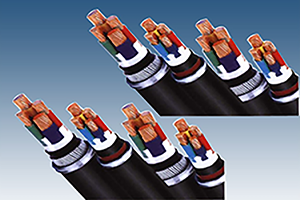The structure of the RF cable is various and can be classified according to different ways and types.
Classified by insulation type
(1) Air Insulated Cable
In the insulating layer of the cable, most of the volume except the solid medium that supports the inner and outer conductors is air. Its structural feature is that it can pass from one conductor to another without passing through the dielectric layer. Air-insulated cables have very low attenuation and are commonly used in UHF.
(2) Half-air insulated cable
This type of construction is an insulated version between the two described above, the insulation of which is also a combination of air and solid media, but the passage of a solid dielectric layer from one conductor to another.
In addition, according to the classification of insulation materials can be divided into: plastic insulated cables, rubber insulated cables and inorganic mineral insulated cables; according to the softness can be divided into: soft cables, flat flexible cables and rigid cables; according to the transmission power size is divided into: 0.5 Below the kilowatts of low power, 0.5-5 kilowatts of medium power, 5 kilowatts of high power cables, etc.; according to the characteristics of the product is divided into: low attenuation, low noise, micro-small and stable phase of the cable.
(3) Physically insulated cables
The internal and external conductors of this type of cable are completely filled with a solid high-frequency dielectric, and most soft coaxial RF cables use this type of insulation.
Classified by cable structure
(1) Symmetrical RF Cable
The electromagnetic field of a symmetric RF cable loop is open type. Due to the radiated electromagnetic energy at high frequencies, attenuation is increased, and the shielding performance is poor. In addition, due to atmospheric conditions, it is often used less frequently. Symmetric RF cables are mainly used in low RF or symmetrical feeds.
(2) Spiral RF cable
The conductor in a coaxial or symmetric cable can sometimes be made into a spiral coil, so as to increase the inductance of the cable, thereby increasing the wave impedance of the cable and the transmission time of delayed electromagnetic energy. The former is called a high-resistance cable, and the latter is called For delaying the cable. If the density of the spiral coil wound in the length direction is different, a variable resistance cable can be made.
(3) Coaxial RF cable
Coaxial RF cables are the most common type of construction. Because the inner and outer conductors are in concentric positions, the electromagnetic energy is limited to propagate in the medium between the inner and outer conductors, and thus has significant advantages such as low attenuation, high shielding performance, use of frequency bandwidth, and stable performance. It is usually used to transmit RF energy from 500 kHz to 18 GHz.
At present, commonly used RF coaxial cables have two types of 50Ω and 75Ω RF coaxial cables. Characteristic impedance 75Ω radio frequency coaxial cable is commonly used in CATV networks, so it is called CATV cable, transmission bandwidth up to 1GHz, the transmission bandwidth of commonly used CATV cables: 750MHz.
RG RF coaxial cable / JIS RF coaxial cable / SYV RF coaxial cable advantages: high purity (OFC) oxygen-free copper conductor, imported solid polyethylene insulation, wear-resistant, corrosion-resistant PVC sheath Long-term rated temperature of 70 °C, the entire series using computer code meter
RG coaxial cable / JIS coaxial cable / SYV coaxial cable is mainly used for security monitoring system (CCTV) in smart buildings, such as the connection between the camera and the monitor screen, the transmission of video signals, so the connection between the cable is usually Also called video line.
Gold-loaded Carbon Desorption
Above-mentioned equipment was successfully developed by Changchun Gold Research Institute in 1998. It has possessed three patents and five monopolized technologies. Desorption solution does not contain sodium cyanide, it can reduce the grade of barren carbon down to 100g/t. The key technology of this equipment is that it can ensure the balance of metal quantity, and avoids gold- accumulating and gold- floating from the equipment, ensures the technological index steady and low cost of it. The content about technological advantages has been broadcasted by Xing Huo Science and Technology of CCTV. This technology was appointed as the energy-saving technology of gold production by National Development and Reform Committee in 2006, and was also appointed as standard equipment in the industry by National Development and Reform Committee in 2007, it passed the technique identifying in 2003, and won the second award of science and technology of China National gold Association, the entire technical level is advanced at home. This equipment has won three patent rights of China. The patent numbers of it are separately: 01241537.5 01241538.5 200620029209.1
Gold Desorption,Fine Gold Separator,Gold Production Process,Gold Refinery Processing Plant
Changchun Gold Research Institute Co.LTD , https://www.changchunmachine.com

